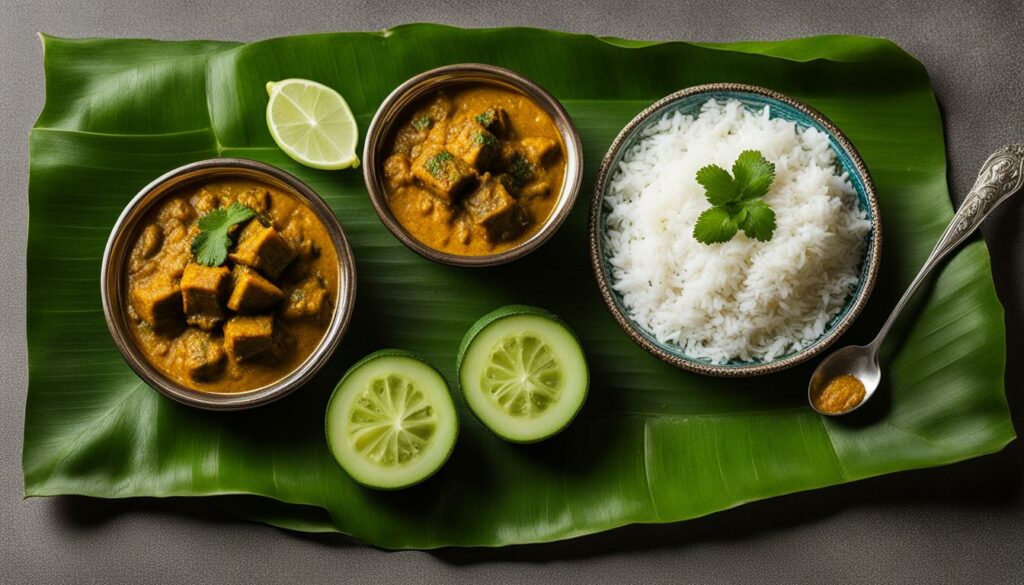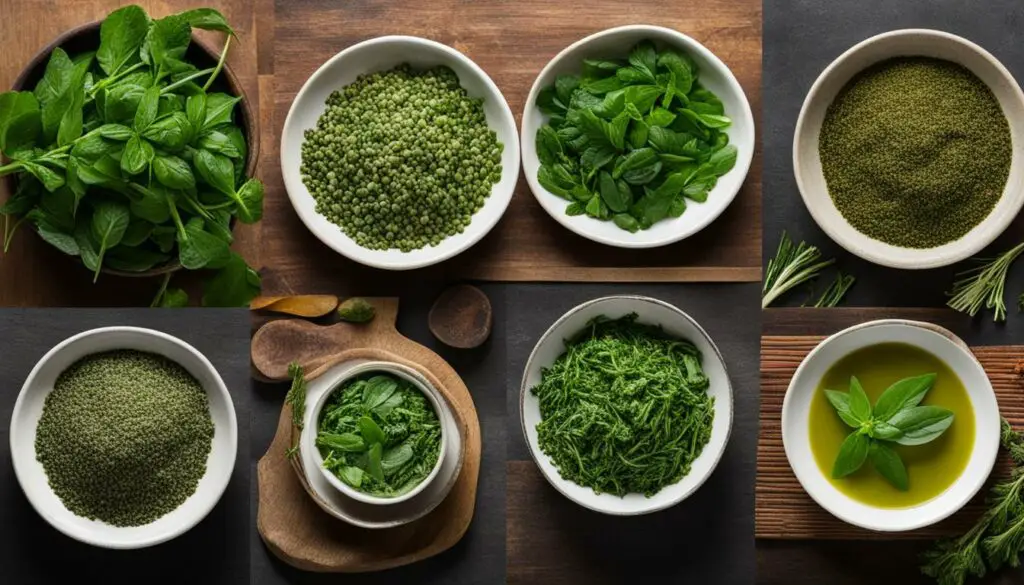Are you looking for a fenugreek leaf substitute? Whether you can’t find fenugreek leaves at your local grocery store or you have an allergy to them, there are numerous alternatives to choose from. In this section, we’ll explore different options for substituting fenugreek leaves in your recipes and provide handy kitchen tips to help you enhance your culinary creativity.
Table of Contents
Key Takeaways
- There are many alternatives to fenugreek leaves for those who cannot use them or cannot find them.
- Understanding the unique flavor profile of fenugreek leaves is crucial to finding the best substitutes.
- Substitutes can be found in both herbs and spices, as well as in other leafy greens.
- When using a substitute, it’s essential to adjust the amount of the ingredient and experiment with the flavor.
- With the right substitute and tips, you can still achieve the same delicious result in your recipes.
Why Might You Need a Substitute for Fenugreek Leaves?
Fenugreek leaves, or methi leaves, are a popular ingredient in Indian cuisine, with a slightly bitter and nutty flavor that adds depth to dishes such as curries, soups, and stews. However, there are several reasons why you might need a substitute for fenugreek leaves:
- You may not have access to fresh or dried fenugreek leaves, especially if you live in an area where it’s not commonly used in cooking.
- If you have a fenugreek allergy or intolerance, you’ll require an alternative to avoid allergic reactions or digestive problems.
- Some people dislike the distinct flavor of fenugreek leaves and prefer not to use them in their cooking.
Whatever your reason may be, having a substitute for fenugreek leaves on hand can help you to continue cooking up delicious dishes without compromising on flavor. Let’s explore some of the best alternative options in the following sections.
Understanding Fenugreek Leaves and Their Flavor Profile
Fenugreek leaves, also known as methi, are commonly used in Indian, Middle Eastern, and North African cuisine. They have a distinct flavor profile that is essential to the dishes they are used in. Understanding this flavor profile is crucial when looking for suitable substitutes.
The taste of fenugreek leaves can be described as bitter with a nutty undertone. It also has a slight sweetness to it. The aroma is pungent and earthy, with a hint of maple syrup. When cooked, fenugreek leaves can add depth and complexity to dishes, making them more savory and flavorful.
Knowing the unique flavor profile of fenugreek leaves can help you find suitable substitutes that mimic their taste and aroma. Let’s take a look at some options for substituting fenugreek leaves in your recipes.
Fenugreek Leaves Replacement Options
If you’re looking for a fenugreek leaf substitute, there are a few options to consider. Some of the most popular substitutes include:
- Celery leaves: Celery leaves have a similar bitter taste to fenugreek leaves, making them a great substitute. They can be used in soups, stews, and curries.
- Mustard greens: Mustard greens have a slightly peppery taste that can mimic the bitterness of fenugreek leaves. They work well in sautéed dishes and as a garnish.
- Kasuri methi: Kasuri methi is dried fenugreek leaves that have been crumbled. It has a stronger flavor than fresh fenugreek leaves and can be used in curries, sauces, and marinades.
- Fennel seeds: Fennel seeds have a similar taste to fenugreek leaves, with a hint of licorice flavor. They can be used in spice blends and marinades.
- Cumin seeds: Cumin seeds have a warm and earthy flavor that can add depth to dishes. They work well in curries, sauces, and marinades.
Experimenting with these substitutes can help you find the best option for your recipes and personal taste preferences.
Fenugreek Leaf Substitute Options in Indian Cuisine

Fenugreek leaves, also known as methi, are a staple in Indian cuisine and are widely used in dishes such as curries, dals, and parathas. However, if you cannot find fresh or dried fenugreek leaves or are looking for alternative options, there are several substitutes that can recreate the unique flavor profile of fenugreek leaves in your dishes.
Kasuri Methi
Kasuri methi is a popular substitute for fenugreek leaves in Indian cuisine. It is a dried form of fenugreek leaves that has a concentrated flavor and aroma, making it an ideal replacement for fresh or dried fenugreek leaves. Simply crush a small amount of kasuri methi and add it to your recipe to enjoy the distinctive nutty and slightly bitter taste.
Mustard Greens
Mustard greens, also known as sarson ka saag, can be used as a substitute for fenugreek leaves in recipes such as saag paneer or dal. They have a similar slightly bitter taste and can be easily found in Indian grocery stores or farmers’ markets.
Celery Leaves
Celery leaves are an excellent alternative to fenugreek leaves for those who prefer a milder flavor. They have a slightly sweet and earthy taste that pairs well with Indian spices and can be used in recipes such as curries or soups.
Spinach
Spinach is a versatile leafy green that can be used as a substitute for fenugreek leaves in dishes such as aloo methi or methi malai paneer. While spinach has a milder taste than fenugreek leaves, it still adds a fresh and vibrant flavor to the dish.
| Fenugreek Leaves | Substitute |
|---|---|
| Fresh or Dried | Kasuri Methi |
| Fresh | Mustard Greens |
| Fresh or Dried | Celery Leaves |
| Fresh or Dried | Spinach |
When using a substitute for fenugreek leaves, it’s important to keep in mind that the flavor profile may differ slightly from the original. You may need to adjust the quantity and pairing of the substitute to achieve the desired taste for your dish.
Try experimenting with different substitutes and incorporating them into your favorite Indian recipes to discover new and exciting flavors.
Alternative Uses of Fenugreek Leaves – Beyond Cooking

While fenugreek leaves are a popular ingredient in many dishes, they are also known for their medicinal properties. In traditional medicine, fenugreek leaves have been used to treat a range of ailments, including digestive issues, inflammation, and hormonal imbalances.
In recent years, fenugreek leaves have gained popularity as a natural remedy for several health issues, including:
- Reducing inflammation
- Lowering cholesterol levels
- Improving digestion
- Increasing milk production in breastfeeding mothers
One of the most common ways to consume fenugreek leaves for medicinal purposes is by steeping them in hot water to make a tea. The tea can be consumed daily to reap the benefits of the leaves.
In addition to its medicinal uses, fenugreek leaves have also been used in beauty and skincare. The leaves are known for their anti-inflammatory properties and are believed to have a soothing effect on the skin. Fenugreek leaves can be used in homemade face masks or added to warm bathwater for a relaxing and rejuvenating soak.
Overall, fenugreek leaves are a versatile ingredient that can provide numerous health benefits beyond their role in cooking. Whether it’s used to alleviate a health issue or incorporated into a beauty routine, fenugreek leaves are a valuable addition to any household.
“Fenugreek leaves have been used in traditional medicine and natural remedies for centuries due to their numerous health benefits.”
Substitutes for Dried Fenugreek Leaves

Dried fenugreek leaves are a staple ingredient in Indian cuisine, but they may not always be available at your local grocery store. Don’t worry; these substitutes can easily replace dried fenugreek leaves in your recipes:
| Substitute | Quantity | Flavor Profile |
|---|---|---|
| Fenugreek seeds | 1 tsp of seeds = 1 tsp of leaves | Bitter with nutty undertones |
| Celery leaves | 1:1 substitution | Herbaceous with a slightly bitter taste |
| Curry leaves | 1:1 substitution | Bitter with a distinct curry flavor |
| Mustard greens | 1:1 substitution | Peppery with slight bitterness |
| Kasoori methi | 1:1 substitution | Similar to fenugreek leaves with a subtle sweetness |
Each of these substitutions has a unique flavor profile that may work better in certain dishes. It’s vital to experiment to find the right flavor balance for your recipe.
If you’re looking for a substitute with a similar flavor profile, fenugreek seeds are the best option. Crush them into a powder and use them in the same quantity as the dried leaves. However, be aware that they have a stronger bitter taste than the leaves.
For a substitute that’s milder in flavor, try celery leaves. They have an herbaceous taste with a slight bitterness, which pairs well with spicy and savory dishes.
Curry leaves are another suitable option. They have a bitter and slightly spicy flavor that works well in Indian recipes. Mustard greens have a peppery taste and work well in soups and stews, especially those with lentils or beans.
Kasoori methi, also known as dried fenugreek leaves, is a fantastic replacement. It has a similar flavor and aroma to fenugreek leaves, with a subtle sweetness that makes it perfect for curries and stews.
Now that you know the best substitutes for dried fenugreek leaves, experiment with different options and find the perfect one for your recipe.
Experimenting with Similar Herbs and Spices

If you’re looking to switch things up in the kitchen, there are plenty of herbs and spices that you can experiment with as alternatives to fenugreek leaves. These alternatives can enhance the flavor of your recipes and create unique taste profiles.
1. Mustard Seeds
Mustard seeds have a slightly bitter taste, similar to fenugreek leaves. Ground or whole, they are a great substitute in Indian dishes such as curries and dals.
2. Cumin Seeds
Cumin seeds have a warm, earthy flavor and are a staple in many spice blends. They can be used as a substitute for fenugreek leaves in Indian dishes, especially in combination with coriander seeds and curry powder.
3. Curry Leaves
Curry leaves are commonly used in Indian cooking and have a slightly sweet and tangy flavor. They can substitute fenugreek leaves in dishes such as chutneys and sambar.
4. Fennel Seeds
Fennel seeds have a licorice-like flavor and add a sweet note to dishes. They can be used to replace fenugreek leaves in spice blends, marinades, and curries.
5. Celery Leaves
Celery leaves have a slightly bitter and earthy taste, similar to fenugreek leaves. They can be used as a substitute in dishes such as stews and soups.
Experimenting with different herbs and spices can be a fun and exciting way to add new flavors to your cooking. Don’t be afraid to get creative and try new combinations!
Tips for Using Fenugreek Leaf Substitutes

Using a fenugreek leaf substitute can add a new depth of flavor to your cooking, but it’s essential to keep in mind a few tips to ensure you get the best results.
Choose the Right Substitute
When choosing a substitute for fenugreek leaves, consider the recipe’s flavor profile and choose a substitute that can mimic that taste. For example, if you’re cooking an Indian recipe that calls for fenugreek leaves, you could substitute with kasoori methi, which is dried fenugreek leaves. If you’re looking to add a similar earthy taste, you could try using celery or fennel seeds.
Adjust the Amount
Substituting fenugreek leaves with another ingredient can change the dish’s flavor, so it’s essential to adjust the amount accordingly. Start with small amounts and gradually increase the quantity until you reach the desired flavor.
Experiment with Combinations
If you’re feeling adventurous, try mixing different substitutes to create a unique flavor profile. For example, try adding a combination of cumin and mustard seeds to mimic the taste of fenugreek leaves.
Use It in Moderation
While fenugreek leaf substitutes can enhance your dish’s flavor profile, it’s easy to overdo it. Use the substitute in moderation to avoid overpowering the dish’s other flavors.
Don’t Substitute for Medicinal Purposes
If you’re using fenugreek leaves for medicinal purposes, it’s essential to consult a healthcare professional before substituting with other ingredients.
These tips will help you make the most of your fenugreek leaf substitute and elevate your culinary creations to the next level.
Cooking with Fenugreek Leaf Substitutes – Recipe Inspiration

Now that you know about the different fenugreek leaf substitutes, let’s explore some delicious recipe ideas where you can incorporate these alternatives seamlessly. These recipes will not only enhance your culinary creativity but also serve as a healthier option.
1. Chickpea and Spinach Curry
| Ingredients | Instructions |
|---|---|
|
|
This flavorful vegetarian curry is packed with protein and nutrients. The fenugreek substitute adds a unique taste that complements the other spices perfectly.
2. Chicken Tikka Masala
| Ingredients | Instructions |
|---|---|
|
|
This classic Indian dish is a crowd-pleaser and now with a healthier twist. The fenugreek substitute adds a slightly sweet and nutty flavor to the creamy sauce.
3. Lentil Soup with Carrots and Potatoes
| Ingredients | Instructions |
|---|---|
|
|
This flavorful soup is a perfect option for a weeknight dinner. The fenugreek substitute adds a dash of warmth to the hearty lentils and vegetables.
Conclusion
Substituting fenugreek leaves in your recipes may seem daunting at first, but with the right knowledge and tips, it can open up new culinary possibilities. Whether you’re dealing with unavailability, allergies, or personal preference, there’s no need to let it hold you back in the kitchen.
The key is to understand the unique flavor profile of fenugreek leaves and explore suitable alternatives, whether it’s other herbs and spices or specific ingredients that mimic the taste and aroma. With a bit of experimentation and creativity, you can create dishes that are just as flavorful and satisfying without compromising on taste.
Takeaways
- Understanding why you might need a substitute for fenugreek leaves is essential before exploring alternatives.
- Fenugreek leaves are commonly used in Indian cuisine, so finding suitable substitutes for traditional recipes is particularly important.
- Alternative uses for fenugreek leaves beyond cooking include their potential role in traditional medicine and natural remedies.
- Experimenting with similar herbs and spices can give your dishes a unique twist and flavor.
- Remember to adjust your cooking methods and use expert tips when using fenugreek leaf substitutes.
- Lastly, don’t forget to explore new recipe ideas using your chosen substitutes.
With the tips and knowledge shared in this article, there’s no reason to shy away from using a substitute for fenugreek leaves. Embrace the opportunity to try new ingredients and elevate your cooking skills. Happy cooking!
FAQ
Why might you need a substitute for fenugreek leaves?
There are several reasons you might need a substitute for fenugreek leaves, such as unavailability, allergies, or personal preference. Having an alternative can be a game-changer in your recipes.
What is the flavor profile of fenugreek leaves?
Fenugreek leaves have a unique taste and aroma. They add a slightly bitter, nutty, and earthy flavor to dishes. Understanding their flavor profile is essential in finding suitable substitutes.
What are some fenugreek leaf substitute options in Indian cuisine?
In Indian cuisine, you can use alternative ingredients like mustard greens, spinach, kasoori methi (dried fenugreek leaves), celery leaves, or curry leaves as substitutes for fenugreek leaves.
Are there alternative uses for fenugreek leaves beyond cooking?
Yes, fenugreek leaves have alternative uses beyond cooking. They are known for their medicinal properties and are used in traditional medicine and natural remedies.
What are some substitutes for dried fenugreek leaves?
If you don’t have dried fenugreek leaves on hand, you can try using fenugreek seeds, ground fenugreek powder, or a combination of other herbs and spices like cumin, coriander, and mustard seeds.
Can I experiment with other herbs and spices as alternatives to fenugreek leaves?
Absolutely! You can experiment with herbs and spices like basil, fennel seeds, mustard seeds, celery seeds, or even curry powder to add a unique twist to your dishes.
Do you have any tips for using fenugreek leaf substitutes?
When using a fenugreek leaf substitute, it’s important to adjust the quantity according to your taste preferences. Start with a smaller amount and gradually increase if needed. Also, consider the flavor profile and cooking time of the substitute in your recipes.
Can you provide recipe inspiration using fenugreek leaf substitutes?
Certainly! Here are some recipe ideas where you can incorporate fenugreek leaf substitutes seamlessly: butter chicken with mustard greens, spinach dal with curry leaves, or a vegetable curry with kasoori methi (dried fenugreek leaves).
Why should I consider using fenugreek leaf substitutes?
Using fenugreek leaf substitutes allows you to explore different flavors and enhance your culinary creativity. It opens up a world of possibilities in your kitchen, allowing you to create delicious dishes even without fenugreek leaves.
See also:

Leave a Reply